A flowering plant of the arrowroot of the Marantov family grows well, multiplies, and blooms for a long time at home. The arrowroot got its name in honor of the botanist and Italian physician Bartholomew Marant, who lived in the 16th century. Today there are about 26 species of this plant, which is valued for its miniature size and very beautiful large leaves. An exotic ornamental plant requires certain care, the features of which we will discuss in this article.
Content
Arrowroot: general description, types, photos
The homeland of the exotic flower is the tropical part of South and Central America and the West Indies. Miniature plant grows up to 30 cm in height and is distinguished by tuberous roots, erect or creeping shoots and broad-oval leaves growing on petioles. Depending on the species, the leaf blade is decorated with brown eye spots, double-row spots or bright stripes along the central vein.
On the upper side, the background of the leaves can be dark green, light green, or even reddish. The underside of the top is very different in color. The color combination of spots and veins located on the leaves is very reminiscent of the patterns of the leaves of the decorative codiaum. The plant blooms with white and light lilac flowers in spring or summer.
The arrowroot flower is known to many for the fact that under favorable growing conditions, its leaves are unfolded, and if the plant lacks light or moisture, the leaves fold into closed rosettes and stretch upward. In this regard, the flower has a second name - "Praying Grass"... Thanks to this, there is a belief that a prayer flower grown in a house is able to protect a family from conflicts, create a favorable atmosphere and cleanse of negative emotions.
Types of arrowroot
At home, two types of arrowroot are most often grown. This is arrowroot tricolor, known as tricolor and arrowroot bicolor. But many plant lovers of the Marantov family grow other species of this tropical flower.
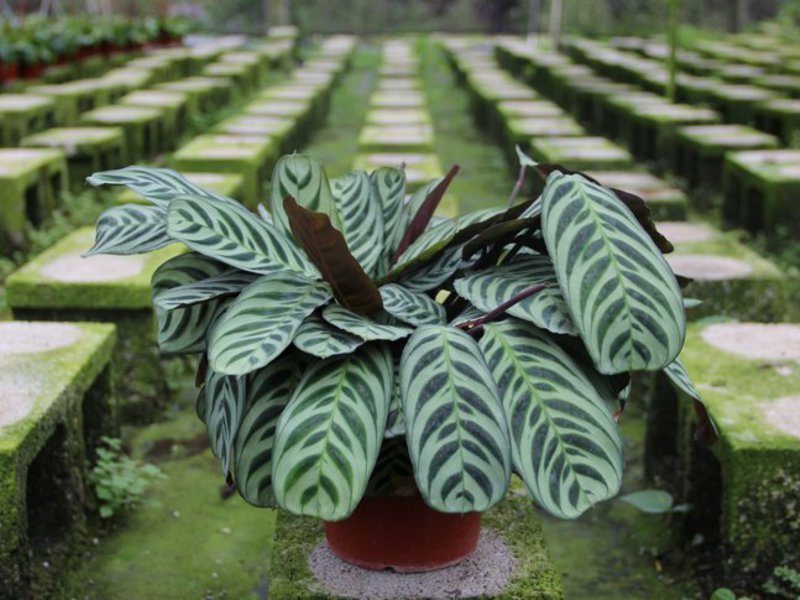

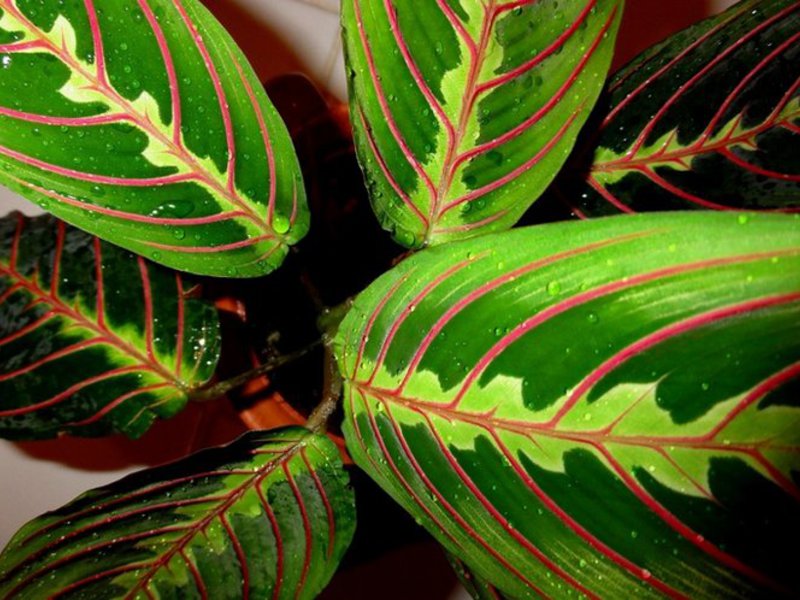
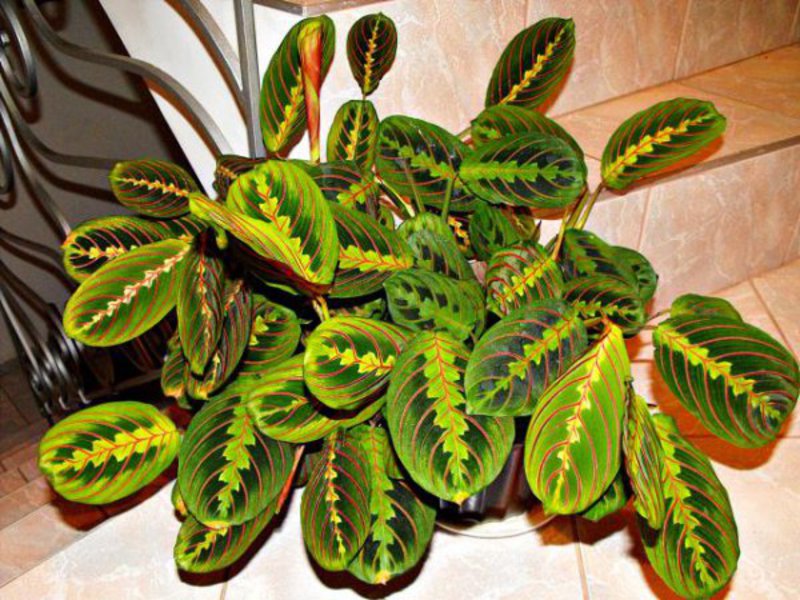
Arrowroot tricolor (tricolor). An ornamental deciduous plant is a bush, the dimensions of which are 30 cm in height and width. The pubescent leaves are 12 cm long and are oval in shape. The background of the upper side of the leaf plate is dark or light green. The leaf pattern is composed of red veins and dark green spots along the lateral and light green spots along the central veins. Below, the leaf plates have a crimson color and pink veins. Arrowroot tricolor blooms with flowers of a light lilac shade.
Arrowroot bicolor. This rather rare plant is distinguished by the fact that it does not form roots. Its leaves up to 15 cm long are distinguished by short petioles, wavy edges and an oval shape. On the green background of the leaf plate, brown spots are located on top. Below the leaves are covered with hairs and have a reddish tint.
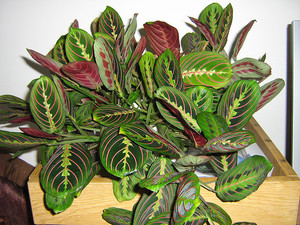 Arrowroot reed. An ornamental plant is a shrub slightly more than a meter high. Its tuberous roots are thick, and the long leaves are ovoid and grow up to 25 cm. The leaf blade, pointed at the top, is dark green below and covered with hairs. White flowers appear on the plant in spring or summer.
Arrowroot reed. An ornamental plant is a shrub slightly more than a meter high. Its tuberous roots are thick, and the long leaves are ovoid and grow up to 25 cm. The leaf blade, pointed at the top, is dark green below and covered with hairs. White flowers appear on the plant in spring or summer.
Maranta Kerhoven. Herbaceous perennial 25 cm high characterized by short leafy roots, oval leaves up to 15 cm long and white-veined white flowers... Above, the leaf plate has a bright green background, on which dark green spots and white stripes are located along the central vein. Below the leaf has a red to bluish tint.
Arrowroot: home care, photo
Arrowroot loves diffused bright light, so it is advisable to place the flower on the windowsill or next to the windows facing the east or west side of the house. In the summer, the plant is mandatory shaded from direct midday sun rays... Otherwise, the leaf blade will decrease in size, the contrasting pattern will fade, and the leaves will curl. In winter, the flower needs additional lighting, which can be provided with a photo lamp.
Air humidity and temperature conditions
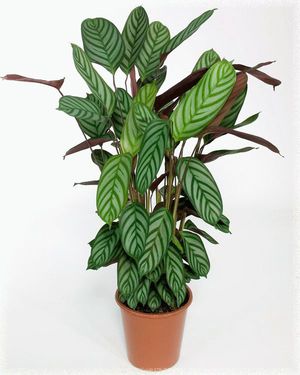 From the end of May to October, at home, arrowroot should be kept at an air temperature within + 21- + 26 degrees. In autumn and winter, the temperature should be reduced to + 18- + 23 degrees. Temperatures below +12 degrees have a detrimental effect on the plant. Temperature changes and drafts can lead to the death of a flower.
From the end of May to October, at home, arrowroot should be kept at an air temperature within + 21- + 26 degrees. In autumn and winter, the temperature should be reduced to + 18- + 23 degrees. Temperatures below +12 degrees have a detrimental effect on the plant. Temperature changes and drafts can lead to the death of a flower.
Arrowroot growing in the house retain their decorative effect at moderate humidity. However, when caring for a plant, you must two - three times a day spray the leaves with warm, settled water... To increase the humidity around the flower, you can do the following:
- Place the pot on a pallet with wet pebbles, expanded clay or peat. In this case, it is necessary to ensure that the roots do not come into contact with the filling.
- Place a container filled with water or a humidifier near the flower.
- On hot days and in rooms with working radiators, arrowroot can be washed under the shower, after covering the soil in the pot with polyethylene.
If the air in the house is too dry, the pattern will cease to be distinct, the leaves will lose their tone, and their tips will begin to dry.
Watering and feeding
In spring and summer, plants are watered abundantly with settled water at room temperature. In autumn and winter, the plant is watered only after the topsoil dries out. When caring for arrowroot, you need to followso that no water remains in the pan. Water flowing down after watering must be drained immediately.
Arrowroots are fed every two weeks. For this, mineral and organic fertilizers are used for decorative deciduous plants, which should be alternated. Groundbait solutions are introduced only after watering the flower.
Soil and replanting arrowroot
The soil for growing arrowroot can be prepared at home by mixing for this in equal parts:
- leafy ground;
- humus;
- peat.
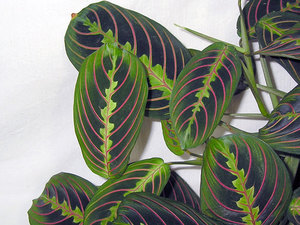 A little coniferous earth and charcoal are added to the resulting earthen mixture.
A little coniferous earth and charcoal are added to the resulting earthen mixture.
The soil may be of a different composition. For its preparation use:
- garden land - 3 parts;
- coarse sand - 1 part;
- peat - 1.5 parts.
Very little charcoal is added to such an earthen mixture.
When caring for arrowroot at home, once every two years, the plant must be transplanted into larger pots. The flower grows slowly, therefore, does not require frequent transplants. Transfer is carried out in March or April in new pots, which should be a couple of centimeters larger than the previous ones. Drainage must be poured into the bottom of the pot.
Arrowroot: reproduction
At home, the plant propagates by cuttings or division.
Propagation by cuttings
To obtain cuttings in late spring or early summer, a part with two to three leaves is cut off from a young shoot. The cut should be about 7–8 cm long. The cut is placed in a container of soft water at room temperature. In about a month, it should take root, and then it can be planted in a pot of peat. To create a greenhouse effect and better survival rate, the petioles are covered from above with a transparent container or a plastic bag. Caring for them consists in keeping the soil moist.
Reproduction by division
When transplanting a plant, an adult bush can be divided into 2-3 parts. This must be done very carefully so as not to damage the roots. Delenki are planted in individual pots filled with peat. The flower is watered, put in a plastic bag together with the pot and tied loosely. Such the mini greenhouse should be kept in a warm room... The package is removed after the appearance of young leaves. Before they appear, caring for the plant consists in daily airing the soil and keeping it moist.
Possible problems when growing arrowroot
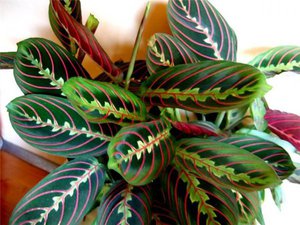 In cold rooms and with frequent abundant watering, the roots and stems of the plant begin to rot. It urgently needs to be rearranged to a warm place without drafts and watering should be reduced.
In cold rooms and with frequent abundant watering, the roots and stems of the plant begin to rot. It urgently needs to be rearranged to a warm place without drafts and watering should be reduced.
Dried leaves with a sticky cobweb indicate that the flower is affected by a spider mite. If the plant is not treated, then over time, the leaves will begin to fall off. Spider mites get rid of folk remedies or using special chemicals. As a folk remedy, a daily infusion of garlic, dandelion, yarrow or onion is used. If this does not help, then the plant is processed by Aktelik.
Dry tips and yellowed foliage most likely indicate that the flower needs moist air. In this case, the leaves need to be sprayed more often and other methods of increasing air humidity at home should be applied.
With a lot of sunlight, arrowroot leaves can turn white. So that they acquire their decorative color again, the flower is placed in a shaded place... If this does not help, then during the growth period the plant must be fed.
It is impossible to call an arrowroot an unpretentious houseplant. In order for a tropical flower to delight the owners for a long time and decorate the house with its decorative leaves, he requires constant attention and care by all the rules.



1 comment